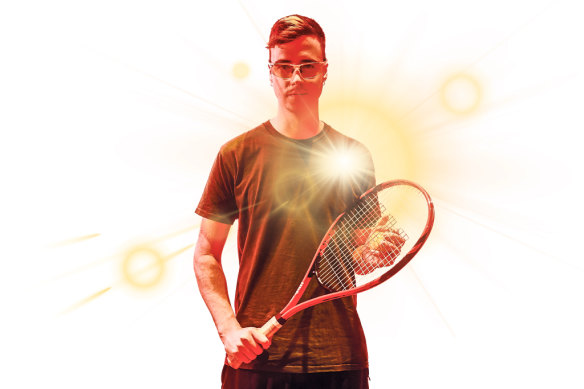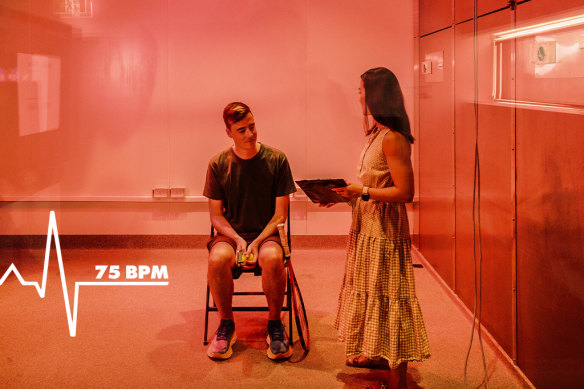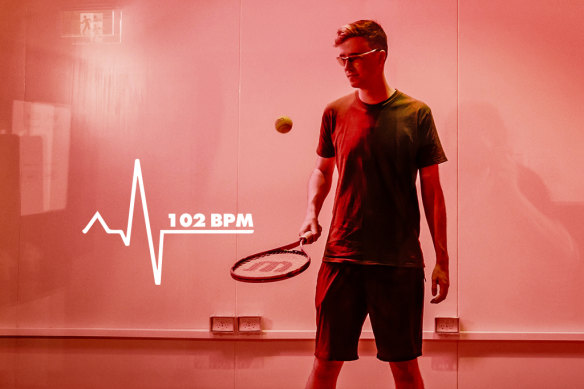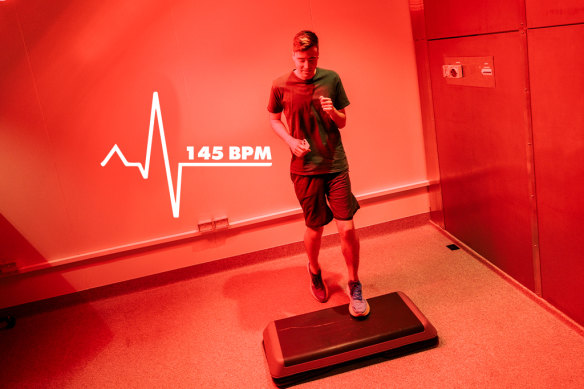Explainer
- Explainer
- Australian Open
‘I’m sitting, but my heart rate is climbing’: How heat stress creeps up on you
Reporter Angus Dalton experienced just what extreme heat can do to your body in a climate chamber for this Explainer with Liam Mannix.
By Liam Mannix and Angus Dalton
Thousands of Australian Open contenders have battled for glory over the years in the sapping conditions I’ve just stepped into. But I’m not on a blue hardcourt under a baking sun in front of 14,000 people, I’m in a very hot room. The door and windows are shut. Lamps bathe the space in a watermelon light. I saunter into the centre. So far, no sweat. But hang on, now my breathing feels … thick.
The Thermal Ergonomics Laboratory is temperature-controlled and humidified by a water boiler. Scientists at the University of Sydney lab – who work with Tennis Australia on the Australian Open’s heat regulations – can recreate extraordinary conditions in this room, including the kind of 35-degree “wet bulb” temperatures that can kill (wet bulb measurements combine heat and humidity, and are typically much lower than the ambient air temperature).
But today, researcher Dr Jem Cheng has opted to expose me to a relatively gentle January scorcher at Melbourne Park.
“It’s pretty hot – 38 degrees Celsius – at about 20 per cent relative humidity,” Cheng says. “I would say that’s on the milder end. This would be a typical summer day in Melbourne in the shade. If you’re out in the heat, if the roof’s open and you’re playing on court, then you’re actually experiencing more heat stress.”
Heat is, famously, the invisible adversary the world’s top tennis players face at the Australian Open, even as factors such as humidity are known for taking a toll in other events, not least the US Open, played in the often-sweltering New York summer. Either way, there’s nothing like a professional tennis match to swing the spotlight on the effects of heat and humidity on humans. Yes, these tennis stars are elite athletes, but everyday people are also being subjected to a hotter climate in many places around the world.
What effects does heat have on them? How does it build up in the body? What can athletes do about it?

Reporter Angus Dalton spent time in a climate chamber. Credit: Brook Mitchell, Marija Ercegovac
How does heat affect humans?
After two minutes in the climate chamber, the right side of my face starts to prickle – it’s exposed to the bank of red lamps suspended above me that simulate solar radiation, or sunlight. After another two minutes, sweat beads on my lip. I’m sitting, but my heart rate is climbing. A flush of heat radiates through my chest as if I’ve just downed a piping long black.
Seven minutes in, the saliva thickens in my mouth. I have a mental mirage of a ball-kid offering me a blue sports drink. I’d love a sip or two right now.
Ten minutes in, and our photographer’s Apple watch lights up – his heart rate has doubled to about 120. Cheng notes: “When you first go in, you’re like, ‘Oh, it’s not that bad.’ But the longer you sit, it’s the accumulation of stress, right?”

Reporter Angus Dalton’s heart rate starts to creep up as he is checked into the heat lab by researcher Dr Jem Cheng.Credit: Brook Mitchell
Scientists split human body temperature into two categories: skin and core. While skin temperature can be measured on the body’s surface, scientists generally measure core temperature using either a suppository thermometer or an ingestible pill.
Surprisingly, the two temperatures are only loosely related. “Skin temperature affects how hot you feel, but it’s not necessary in lockstep with how hot you are inside your body,” says Professor Ollie Jay, director of the Thermal Ergonomics Laboratory. “You get sick because your core temperature goes up to a certain level.”
For our organs to work optimally, we need to maintain a core temperature within a fairly narrow range: 37 degrees, give or take half a degree. Generally, the body can happily handle an increase in core temperature to about 39 degrees, says Jay.
One study that monitored elite tennis players during a simulated match found that, after about two hours of play in hot conditions, their core temperature jumped to 39.4 degrees.
The risk of heatstroke starts to increase when your core temperature rises above 40 degrees. Heatstroke is an acute body-wide inflammatory reaction that can lead to multi-organ failure and death. However, 40 isn’t a hard limit. Elite athletes can often tolerate higher core temperatures, with some even able to push 41 degrees without ill-effect, says Jay.
‘Humidity can be lethal. This is aggravated further if the air is still instead of windy.’
Luckily, our bodies are extraordinarily good at maintaining a core range – through blood flow and sweating. Increasing blood flow to and in the skin by widening the blood vessels allows the body to take excess heat away from the core – the warming organs – to the surface, where it can be shed. In normal conditions, about 250 millilitres of blood flows to the skin per minute; during heat stress, the flow can reach eight litres. This surfaced heat can then be whisked away using sweat. Human bodies have what researchers term a “tremendous capacity to sweat”. Some studies have found people can excrete up to four litres of sweat an hour.
Turning a liquid into a gas demands a significant amount of energy; when sweat evaporates, heat is consumed in the transformation, cooling the body. One research paper modelled the maximum heat loss provided by sweat to the equivalent to standing outside, naked, in the wind, on the coldest day ever recorded in the United States.
As external temperatures rise to around 35 degrees, the body reaches a point where it cannot release heat into the environment without sweat-powered evaporation. This brings us to a key wrinkle: humidity. As the amount of water in the air increases, the efficiency of sweat-powered cooling decreases. Too humid, and the body loses much of its ability to cool itself – which is why humidity, not just heat, is a key component of the Australian Open’s heat management policy (more on this later). “That’s why humidity can be lethal,” says Jay. “This is aggravated further if the air is still instead of windy. Wind helps a lot more sweat evaporate, even if it is quite humid.”
Compared to the Australian Open, the US Open is often played in extremely humid conditions, limiting the evaporation of sweat. In September, player Daniil Medvedev told reporters after one match at Flushing Meadow “because we were sweating so much and used a lot of towels, I have no skin left on my nose”. Jay has done simulations of the typical conditions of the two events in his laboratory, and says participants can do worse in US-like conditions.

The exertion of bouncing a ball on his racquet has Dalton’s heart rate top 100 beats per minute.Credit: Brook Mitchell
There’s ample evidence that increases in heat stress lead to reductions in athletic performance. In aerobic studies, athletes report their “time to exhaustion” as 45 minutes sooner. Marathon runners slow down. Heat stress reduces VO2 max – the maximum amount of oxygen an athlete can consume. A tennis player who can’t get as much oxygen will feel extreme fatigue across all their muscles; heat also independently increases feelings of fatigue in muscles.
It’s as if my body is working so hard to keep cool that my energy levels aren’t being replenished.
Humidity adds yet another layer of difficulty. In one study of 14 athletes working out in either hot or humid conditions, the researchers found higher humidity led to an increase in core temperature, a reduction in blood pressure – and a drop in athletic performance.
Where exercise and sweating lead to dehydration, decreases in performance can be dramatic. Dehydration reduces blood volume – a lot of your blood is water – and decreases VO2 max. Less blood volume, or blood being redirected to the skin to help keep you cool, means there is less blood available to service an athlete’s hard-working muscles.
Back in the chamber, after about 20 minutes, even sitting down doesn’t feel like a break. It’s as if my body is working so hard to keep cool that my energy levels aren’t being replenished. The researchers can track the effects on core body temperature (measured by a digestible pill monitor), skin warmth and metabolic rate, as well as how much sweat a subject is losing and where it gathers on their bodies. In my case, we’ve tracked the effort my body has to make to keep cool by one simple measure: my heart rate.
Is it getting hotter at the Australian Open?
Atmospheric carbon dioxide levels have crossed 417 parts per million – the highest level in at least a million years, according to ice-core data. All that carbon traps heat: Australia has warmed by about 1.47 degrees since records began in 1910. The average maximum January temperature in Melbourne rose by 1 degree from 1988-2007 to 2012-2022, the Bureau of Meteorology says. That average increase is being driven, in part, by a jump in days of extreme temperature.
The Opens in 2009 and 2014 were brutally hot. On day 12 in 2009, the temperature hit 45.1 degrees; then-reigning champion Novak Djokovic retired that year due to heat stress. In 2014, as it got to 42 degrees, Ivan Dodig was forced to withdraw from a match, collapsing half an hour later with full-body cramps (from depleted salt levels in his body). “I was thinking I could maybe even die here,” he said.
In 2018, after playing for two hours and 45 minutes against Gael Monfils as Rod Laver Arena reached 39 degrees, Djokovic said: “People might say at this level you have to be, as a professional tennis player, fit. It’s the beginning of the season, you work and train hard to be able to sustain these kinds of conditions and be tough, but I think there is a limit and there is a level of tolerance between being fit and being in danger in terms of health.”
Last year was a relatively cool tournament: just one day over 30 degrees. But 2022 was a scorcher: eight days of 30 or hotter.
The Australian Open has had extreme heat policies since the late ’90s, adjusting the rules over time, including after 2014 and again after 2018. At the Open, Jay’s team places environmental measuring systems – they call them EMUs – courtside. The devices measure all the factors that drive heat stress: air temperature, radiant heat (the strength of the sun), humidity and wind speed. They’re combined into the Australian Open Heat Stress Scale, which goes from one to five; at five, play can come to a halt once an even number of games has been reached.
So, can players (and the rest of us) acclimatise?
Athletes have started to view the heat not as an impediment, but as an opponent. Heat acclimation training, taking advantage of the body’s natural ability to adapt to heat, is now par for the course. “Athletes have been doing this for a while, but it’s become more prevalent now,” says Darren Rockawin, part of a team at Victoria University studying acclimation. Most experienced pros now try to play at least one tournament in Australia before the AO.
A heat-trained athlete will have a lower resting heart rate, a higher amount of blood plasma, muscles that use less oxygen and a higher sweat rate. “If they become better at sweating, they can train harder, they can compete for longer because they are cooling their skin and core temperature,” says Rockawin.
Getting there is hard. Typically, a player will need to work out for at least 90 minutes a day in conditions 30 degrees or above, for 10 days in a row. But there’s good evidence the approach works: a meta-analysis of 96 studies found performance improvements of up to 23 per cent, likely due to increases in the ability to absorb oxygen.
In theory, non-athletes could do this too, but modern air-conditioning probably means few people in cities would be exposed to the prolonged hot conditions needed for the effects to kick in, even during a hot summer, says Jay.
‘If you are depleted of all your sodium and glucose, then you basically are not going to absorb much fluid.’
Some players, including Ash Barty and Thanasi Kokkinakis, have taken heat preparedness a step further with sweat tests.
Everyone sweats at a different rate, which is largely determined by genetics. The composition of our sweat also differs from person to person, with some people sweating out more sugar or sodium than others. This poses a problem. Sweat too much, and you risk dehydration. To replace that sweat, the body pulls water through the small intestine and into the blood, but this process relies on the right balance of sodium and sugar – if there’s not enough sodium, the body struggles to absorb water.
Former world No. 1 Andy Murray called in the sweat testers in 2022 after cramping up in a series of matches. “I am doing sweat-testing in these conditions to see if anything has changed because the sports drinks and electrolytes I have are made specifically based on my sweat, but I haven’t done testing for a number of years,” he said at the time. (There are facilities around Australia that do sweat testing, and there are DIY test kits on the market.)

Nearly half an hour in the lab and a short step exercise doubles Angus Dalton’s heart rate. Credit: Brook Mitchell
Luckily, the solution is fairly simple: a personalised drink mix containing the same levels of sodium and glucose the player sweats out.
Meanwhile, although the average person would know they are struggling and slow down, or seek shade, a tennis player competing for glory “might not necessarily listen to their body and slow down,” says Jay. That’s why the Australian Open has a heat stress policy, “to intervene before it gets too dangerous”.
Back in the chamber, I finish my session with a short step exercise, jogging on the spot up and down a small platform. With that gentle exertion, my heart rate soars past 140 – double my resting rate – and my shirt clings to my back. My mind feels furry too. In this room, it’s easy to understand how mild-mannered players can become red-cheeked and tetchy after a few sets, especially during close games when the heat is on.
Get fascinating insights and explanations on the world’s most perplexing topics. Sign up for our weekly Explainer newsletter.
Let us explain
If you'd like some expert background on an issue or a news event, drop us a line at explainers@smh.com.au or explainers@theage.com.au. Read more explainers here.